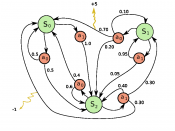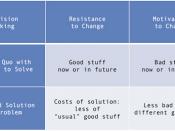There are many decisions that people make in life; however, the effort that goes into the decision shows the quality. As quoted by J. K. Rowling, "It is our choices... that show what we truly are, far more than our abilities". So how does one make sound choices and good decisions, and what tool are available to aid in the decision making process? In the following are some decision-making models such as rational, political, process, garbage can, and the seven-step process. Provided is an example on how these tools when applied within my work organization enable good sound decisions.
One methods of critical thinking is the Rational. This process uses a logical, chronological methodology, based off pre set goals and objectives and finding numerous solutions, choosing the one that best fits the objectives. This is a very simple model; however, it assumes that there will be no biases and human emotion will not allow this.
A second method is Political, which is more common in business situations. In this method, the decision maker may have multiple people working on a project. Each player may have a different agenda or solution and all will pitch their idea to the decision maker. The decision maker will chose the solution he feels would correct the problem. This method commonly has less conflict because players usually follow the decisions once a leader makes a decision.
Another method is Process, which is similar to the Political process except that there are more guidelines and a standard to enforce an outcome defined by predetermined guidelines.
The Garbage Can method is more realistic within the business world as it is a judgment method. This model is not well defined, team players may change, and problems, solutions and decision makers may not necessarily relate to each other.
Finally, there is the seven-step path, which will be covered in more depth and used in a situation within my work environment. The seven-step process consists of the following: stop and think, clarify goals, determine facts, develop options, consider consequences, choose, and monitor and modify.
Stop and Think is a very simple and basic process commonly overlooked, usually due to time constraints. Most people make decisions for the heat of the moment without giving real thought to the ultimate outcome. This basic step means to remove oneself from a situation, look in from the outside, and define the real problem.
The next step, Clarify Goals, determines the desired outcome. If this step is not accomplished, it could jeopardize future goals. A rash decision could solve an immediate problem; however, it could have severe effects in the future.
Determine Facts stage or the accumulation of information to help support the decision comes next. The important part of this process is producing facts, ensuring that the information is reliable and credible. This step of the process requires an open mind because information should be gathered from all aspects, even those that my not interest all involved parties.
From there begins the Develop Options phase, where plans are made and processes put in place to guide and keep the goals on track. The options should consist of many ideas, good, bad or indifferent, keeping an open perspective through the entire process.
Consider Consequences follows next, and without this step, sound choices are almost impossible to make. It must be known who this decision will affect and how, ensuring that the changes are ethical.
Now it is time to Choose, remembering to give others the respect and dignity they deserve, choosing the best outcome for all parties involved.
Finally, there is the Monitor and Modify process. This step it lookout for disturbances from the newly implemented idea. It is a constant check and balance system that could even cause the critical thinking process to begin again.
Within my current organization, a recent issue required the use of this process. Our work papers called Production Inspection Records (PIR) are issued to the floor for manufacturing to work and they do not contain a bill of material (BOM) (a list of parts that build the assembly). Our procedures reflect that all PIR's are required to have BOM's. During recent audits, our department was receiving write-ups for incorrect planning methods, tasking our department to add a BOM to each PIR.
Our department then had to Clarify the Goals for this consequence, the need to reduce error rates and then start to Determine the Facts. The main issues in this scenario were the policies and procedures, and the purpose for which there are not BOM's. In this phase, some interesting facts started to appear. There was not a BOM because the information was contained within another system in another department. So were we to conform, or were we exempt from company policy?
From this, we began to Develop Options that would be the best solution. Our department could go in and update the BOM to match the other system, or change the policy and procedures to reflect our current planning. A meeting was then set up between all team players to discuss the ideas that generated and see if there were any other suggestions.
The team decided that changes to the BOM could be generated, but at costly rework costs. It would take hours to update all 700 + PIR's, and the outcome would gain us nothing. The other option, updating the procedures to reflect the current work practices is valid; however, would that defeat the customer requirements? Finally, the project is on a down swing and the future is dim, so what is the return on investment.
Our organization found a current system that tracks all parts outside our process and it is acceptable to the customer. Therefore, the remaining question was as follows, update the BOM on PIR's to keep consistent throughout the company, or change the process for our program.
The team players once again join to begin the Choice process, to make a final decision on a new direction. The decision made keeps the planning documents as usual for two reasons. The first is the cost versus the return on investment for a program that is winding down; we could never recoup our expenses. Secondly, the current tracking system was acceptable to our customer, so the decision was to update the procedures. The Monitor and Modify phase is just beginning updating the procedures to support or work methods.
I summary, the seven-step model for decision-making works well keeping open minds and by following all rules for engagement. There are many models for processes like the one shown in the previous, but the choice falls on the individuals as to what model best fits the organization.
References
Josephson Institute of Ethics, The Seven-Step Path to Better Decisions, Retrieved 03/11/2004, from http://www.josephsoninstitute.org/MED/MED-4sevensteppath.htm
Lahti, Ryan K., CSWT Papers, Group Decision Making within the Organization: Can Models Help?, Retrieved 03/11/2004 from http://www.workteams.unt.edu/reports/lahti.htm


